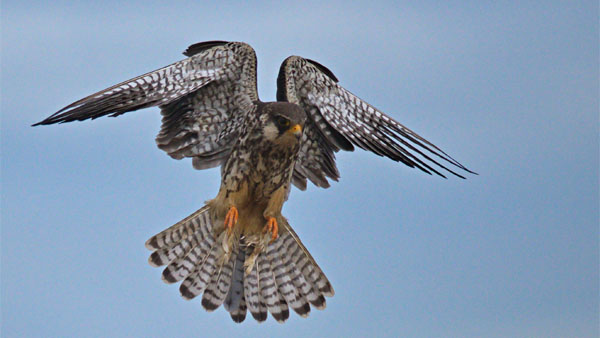By Dipak Kurmi
The Amur falcon (Falco amurensis) is one of the world’s most fascinating migratory birds, renowned for its incredible journey spanning over 22,000 kilometers each year. Native to far eastern Asia, this small, yet remarkable bird embarks on an annual migration that takes it from its breeding grounds in the Amur River region, located in northeastern Asia, all the way to southern Africa. During autumn, these birds head southward, skirting the Himalayas and crossing the Indian Ocean before traveling through East Africa to reach their wintering grounds in South Africa. Come spring, they make the reverse journey, returning to their breeding grounds in Asia.
Physical Characteristics and Behavior
The Amur falcon is a medium-sized bird of prey, with a wingspan ranging from 63 to 71 cm and a weight of around 120 grams. The male Amur falcon has a distinct appearance, sporting a sooty grey body with brownish-red thighs and a white lining on its wings, which stands out when the bird is in flight. The female, in contrast, has a more typical falcon plumage, with a dark, spotted chest and vent against a white background and a grey back. Both sexes feature a striking orange eye-ring, beak base (cere), and feet, which adds to their beauty and uniqueness.
One of the most interesting aspects of the Amur falcon is its social nature. Unlike many other raptors that are solitary, Amur falcons are known to breed, migrate, and roost in large, often communal groups. Their roosting behavior is particularly notable, with flocks of anywhere between 5 to 15 birds to as many as 250 individuals descending from the sky at dusk. In some areas of South Africa, where they spend their winter, roosting trees can host up to 5,500 birds. The Amur falcon’s social nature extends to hunting as well, where large numbers can be seen hunting swarming insects like termites, grasshoppers, and dragonflies.
The Long Migration: From Asia to Africa
Every autumn, as the weather begins to cool in their breeding grounds in northeastern Asia, the Amur falcons embark on their remarkable migration. They travel southward, first rounding the Himalayas and making a stop in Nagaland, northeastern India. From there, they either cross the Bay of Bengal or take an inland route over India before reaching the Western Ghats and the west coast of India.
The real challenge of their migration comes when they cross the vast expanse of the Indian Ocean, a journey that typically takes four days. There are no places to land during this flight, and no food to be found, unless the falcons happen upon a swarm of migrating globe skimmers over the ocean. They are thought to use the prevailing southwest winds to carry them toward Africa, guided by the atmospheric pressure systems in the region.
Once they reach the African continent, their journey is far from over. The falcons continue their flight southward, crossing through East Africa, before finally arriving in South Africa, thousands of kilometers from their origin. This incredible journey, spanning multiple continents and crossing the ocean, is a testament to the falcon’s endurance and navigational prowess.
Return Journey and Wind Patterns
In late spring, the Amur falcons begin their return journey to Asia. This time, they benefit from the change in wind patterns over the Indian Ocean. The Somali Jet, which flows northeastward along the Horn of Africa, guides the birds as they cross the Arabian Sea. By avoiding the difficult Himalayan crossing, they follow a more direct route across India, reaching their breeding grounds in the Amur River region once again.
The Continental Route: A Comparison with the Beijing Swift
Another bird species that migrates from Asia to Africa is the common swift (Apus apus), with some populations—such as the Beijing swifts—breeding in areas overlapping with the Amur falcon’s range. However, unlike the Amur falcon, which crosses the Indian Ocean, Beijing swifts take the continental route. They round the Himalayas to the north, avoiding the vast ocean altogether.
The Amur Falcon’s Diet
The Amur falcon is primarily an insectivore, with insects making up the majority of its diet. These birds are adept hunters of large swarms of insects, including termites (particularly alates), locusts, grasshoppers, and dragonflies. Occasionally, they will also hunt small animals like lizards, rodents, and birds, adding variety to their diet. Their feeding strategy often involves hunting in groups, especially when targeting swarming insect species.
Distribution and Migration Routes
The Amur falcon is found in the Amur River region, spanning southeastern Russia, northern China, and eastern Mongolia, and sometimes reaching the Korean Peninsula. During migration, they cross several countries in Asia, including China, Bangladesh, Bhutan, Nepal, Myanmar, Thailand, Pakistan, and India. While crossing the Indian Ocean, they are also seen on islands such as the Maldives, Seychelles, and the British Indian Ocean Territory.
In Africa, Amur falcons winter in countries like South Africa, Namibia, Botswana, and Zimbabwe. During migration, they are spotted throughout East Africa, including Zambia, Mozambique, Kenya, Tanzania, and beyond, including parts of the Middle East, such as Saudi Arabia, Oman, and Bahrain.
Conservation Issues in India
The Amur falcon’s migration route brings it to northeastern India, particularly Nagaland and Manipur, where hundreds of thousands of falcons stop over during their autumn migration. Historically, this migration has led to significant human-falcon interaction. In the early 2000s, when the Doyang Dam was completed, local fishermen turned to hunting the falcons as a source of food, leading to the systematic mass slaughter of up to 120,000 birds annually.
In 2012, the issue of overhunting was brought to light by organizations like Conservation India, which sparked a significant public outcry. In response, the Indian government, along with local conservation organizations, has effectively banned the hunting of Amur falcons. The Nagaland Wildlife & Biodiversity Conservation Trust (NWBCT) has initiated education programs to raise awareness about biodiversity protection, and local businesses are now promoting eco-tourism as a sustainable alternative to hunting. As a result, the numbers of Amur falcons killed in the region have significantly reduced.
The Amur falcon is a symbol of resilience and endurance, undertaking one of the most remarkable migrations in the avian world. Its journey from the Amur River region to South Africa and back, covering vast distances across multiple continents and oceans, is an awe-inspiring feat of nature. As conservation efforts in India have shown, it is crucial that we protect these migratory species from human exploitation and preserve their natural habitats. The Amur falcon’s migration is not just a natural wonder; it is a reminder of the importance of biodiversity conservation and the need for sustainable practices to ensure the survival of these incredible birds for generations to come.
(the writer can be reached at dipakkurmiglpltd@gmail.com)




